
© TRAIANFIELD
“I’m honoured to be the President of The Wildlife Trusts at such a critical time for the natural world.

“I hope that through lending my voice and support, and by working together, we can help to enforce the changes that must take place in order to secure a brighter future for our wild places and the people and communities who depend on them.”
Liz Bonnin

SAND DUNES © NORTHUMBERLAND WILDLIFE TRUST
2 | The Wildlife Trusts OUR YEAR FOR WILDLIFE & CLIMATE
Forging the way towards nature’s recovery

Armed with a new strategy, with bold goals and ambitions to bring wildlife back and mobilise communities across the UK to take meaningful action for nature, The Wildlife Trusts are energised and determined in our progress towards a wilder future.



Membership of The Wildlife Trusts is at an all time high, growing the ranks of people standing by our side demanding better for the natural world. Our profile has also soared, with media coverage on the rise, and politicians showing signs that they are listening to our pleas that the UK’s wildlife — and people — deserve better. This has led to several notable successes, including the passing of the 2021 Environment Act, thanks to the tireless campaigning of our supporters and those of fellow environmental charities.
Alongside our campaigning and advocacy work, as the UK’s seventh largest landholder* and with our landholdings expanding, our ability to deliver nature’s recovery at scale is allowing us to have a direct impact on nature’s recovery. This work also allows us to showcase and educate others on the benefits of nature-based solutions and the role our natural habitats can play in addressing both local and global problems, including climate change, food productivity and the health and wellbeing of those living in the UK.
Whilst short-term political turmoil and uncertainty can definitely deliver a blow — in the long term the stage is set to deliver for nature and people. And of course, none of the above would be possible without the unstinting and loyal support of our members, supporters, funders and partners. So thank you!
© T R A I ANFIELD © D A N I EL THI
HWAITE
Chief Executive of The Wildlife Trusts Chair of The Wildlife Trusts
3
OUR YEAR FOR WILDLIFE & CLIMATE The Wildlife Trusts |
A year for wildlife — Highlights from across The Wildlife Trusts




©JAMESADLER
Ten new projects were unveiled as part of The Wildlife Trusts’ 30 by 30 ambition to put nature in recovery. The innovative projects included Norfolk Wildlife Trust’s ice-age pond revival, Cumbria Wildlife Trust’s improvement of 30 acres of hay meadow for wildflowers, and Lincolnshire Wildlife Trust’s pilot of eco-friendly ‘Naturehoods’ — creating habitats throughout Lincolnshire communities.
©ANDREWMASON
Thanks to funding from the players of People’s Postcode Lottery, Scottish Wildlife Trust was thrilled to witness three osprey chicks hatch at the Loch of the Lowes Wildlife Reserve in Perthshire. The Osprey Protection Programme, supported by 50 volunteers and staff, ensured the nest remained protected and undisturbed, helping the newborn chicks to thrive.

©FRACKFREEMISSION
Nottinghamshire Wildlife Trust celebrated a hardfought victory when the County Council refused an application for shale gas exploration at Misson Springs, just 125 metres from the Misson Carr Nature Reserve and Site of Special Scientific Interest. They stood shoulder to shoulder with campaigners and the local community to fight the application and protect the rare breeding birds and the fragile fenland habitat the development threatened.
©THEWILDLIFETRUSTS

Surrey Wildlife Trust and the local community of Guildford purchased Pewley Meadows — a patch of rare chalk grassland on the North Downs — after raising over a million pounds in just three weeks! The meadows, with their spectacular views across the county, are home to nesting skylarks, chalkhill blue butterflies, bumblebees and orchids. A new nature reserve will be created to preserve the land in perpetuity for wildlife and people. Cel Spellman (pictured), actor, broadcaster, passionate environmentalist, and ambassador for The Wildlife Trusts, paid a visit to the site to meet the team and celebrate their success.
©SIANADDISON
Hampshire and Isle of Wight Wildlife Trust installed a new ‘Seabin’ to help tackle marine litter in the Solent. Launched as part of the National Marine Week celebrations, the Seabin will collect over one tonne of litter each year — the equivalent of 50,000 plastic bottles. The award-winning technology sits in the water, floating up and down with the tide, sucking water and litter into an internal catch bag that can store microplastics as small as 2 mm. The Seabin will help protect marine life and raise awareness of the damage that litter has on the environment.
©ROSSHODDINOTT/2
Dorset Wildlife Trust launched a major fundraising appeal for England’s first largescale community rewilding project, on 170 hectares of land near Bere Regis. The exciting vision for the area includes the creation of 11 hectares of new community woodland and 30 hectares of new wetland, alongside a new community orchard, space to grow food sustainably, plus room for visitors and locals to explore the wild, helping them to forge a connection with nature.
020V I S I O N
©STEVENMORRIS
Two nature reserves managed by Northumberland Wildlife Trust scooped prizes at the 2021 National Land Trust Awards. Weetslade Country Park secured the Site of the Year Award, recognising the improvements made to the park to create new areas for ground nesting birds and enhance visitor experience. The Project of the Year Award was presented to the team of volunteers at Northumberlandia who braved the freezing weather last January to improve access to the head of the 100-foot-high sculpture, nicknamed The Lady of the North.

©ROSSHODDINOTT/2
Following more than 10 years of campaigning to protect nature from a poorly designed HS2 route, Derbyshire Wildlife Trust, Sheffield and Rotherham Wildlife Trust and Yorkshire Wildlife Trust welcomed the UK Government’s decision to scrap the Phase 2B Eastern leg of the development. The joint effort to force HS2 Ltd to rethink this phase of the project has protected threatened species and delicate ecosystems from potentially catastrophic construction that would forever change the landscape and established habitats.

©JULIEHATCHER
Marine wildlife up and down the coast of the UK was celebrated in The Wildlife Trusts’ 2021 Marine Review, including sightings of a pufferfish on Downderry beach by Cornwall Wildlife Trust, and an abundance of furrowed crabs and ringneck blennies, a small fish from the Mediterranean, which showed signs of breeding in the English Channel. The report also raised concerns about the impact of human activity, specifically large cruise ships damaging the seabed and jet ski and motorboat use disturbing sensitive animals.

©ANGLIANWATER
The fossilised remains of Britain’s largest ichthyosaur, colloquially known as a ‘sea dragon’, was discovered at Rutland Water Nature Reserve. It is the biggest and most complete skeleton of its kind found to date in the UK and is also thought to be the first ichthyosaur of its species found in the country. The ichthyosaur was discovered by Joe Davis, Conservation Team Leader at Leicestershire and Rutland Wildlife Trust, which manages the nature reserve in partnership with the water company, Anglian Water.

Suffolk Wildlife Trust announced an exciting and innovative partnership with Suffolk Building Society to champion nature and help local people save money! The building society supports the #TeamWilder ethos in a bid to help protect nature in the region. Customers can choose from two savings accounts that benefit the Wildlife Trust and offer 50% off a oneyear Suffolk Wildlife Trust membership.
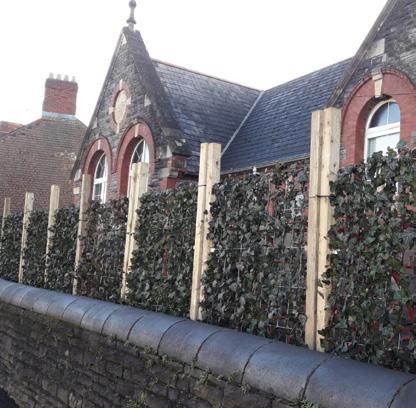
The aptly named ‘Nature Reserve Regular Saver’ is an adult savings account that also comes with a pack of bee friendly seeds. The Suffolk Young Saver is a savings account for young people and children under 21 and comes with a pack of Wildlife Top Trumps.
The Wildlife Trust of South and West Wales celebrated the success of its Green Walls Project with Cardiff Local Nature Partnership. The project created living walls of plants attached to buildings and other structures to improve insulation and air quality, reduce noise pollution, provide habitats for birds, bats and insects and bring people closer to nature. The two sites chosen for the pilot project (the Dusty Forge Centre and Kitchener Primary School), will provide a haven for wildlife for years to come.

020V I S I O N
020V I S I O N ©
©CHRISGOMERSALL/2
Wherever you are in the UK, there is a Wildlife Trust working to bring wildlife back and empower people to take meaningful action for nature. We are a collective of place-based independent charities, working collaboratively and with others to make a positive difference to wildlife and future generations.

We are united by a common strategy, Strategy 2030, with ambitious goals and transformations. This propels us towards our vision of a thriving natural world, where everyone is inspired to get involved in nature’s recovery, and where wildlife plays a key role in addressing the nature and climate emergencies. Whilst it is an ambitious and complex challenge, this vision is not a fanciful dream. It is a necessity — and the solution to the very real and present dangers that nature and people face.
Our combined ability to react and respond quickly to emerging threats, to galvanize people to take action, and our collective knowledge, experience, ‘localness’ and innovative ways of working, are our core strengths. Together, and with the support of local communities, businesses, and our members who stand with us, the network of Wildlife Trusts is in the best place possible to turn our vision into a reality — and ensure the recovery of our natural world.
More than 900,000 members. 1,000s of staff and volunteers. 100s of partnerships. 47 independent charities. One movement.
Nature is in recovery with abundant, diverse wildlife and natural processes creating wilder land and seascapes where people and nature thrive.
Our Strategic Goals
are taking meaningful action for nature and the climate, resulting in better decision making for the environment at both the local level and across the four nations of the UK.
Our Enabling Priorities
Our Strategic Transformations
2
3
1
3 Inspiring community organising
especially
4 Undergoing
digital
5 Delivering
2 Working
1 Supporting
2 Ensuring
3 Develop
4 Invest
5 Speak
OUR YEAR FOR WILDLIFE & CLIMATE The Wildlife Trusts | 7
1
People
Nature is playing a central and valued role in helping to address local and global problems.
Getting our own house in order.
and mobilising,
amongst young people.
a ‘root and branch’
transformation.
a step-change in the scale and diversity of funding for nature’s recovery.
effectively as a distributed network and collective movement.
and developing Wildlife Trusts as strong and effective independent actors.
our nature reserves and land assets are the foundation for nature’s recovery.
clear and consistent evidence-based policies.
in a high-skilled and diverse staff and volunteer network, and build a movement-wide learning culture.
with a bold and confident voice, further increasing our impact and influence.
Nature is in recovery
with abundant, diverse wildlife and natural processes creating wilder land and seascapes where people and nature thrive.
With 15% of our species threatened with extinction, and 41% suffering from serious decline since the 1970s, the UK has the unenviable tag as the one of the most nature depleted countries in the world.
Goal 1 in The Wildlife Trusts’ Strategy 2030 aims to directly address the very real and immediate threat to nature by reversing the decline.
It has become clear that protecting what we have left is no longer enough. We need to create new spaces for nature by connecting habitats, restoring landscapes, undertaking large scale rewilding, and reintroducing ‘keystone’ species. In the past year, The Wildlife Trusts have started to make the changes needed to achieve Goal 1 and put nature in recovery:
• We successfully fought for the first ever sea sanctuaries, resulting in Defra announcing the introduction of HPMAs (Highly Protected Marine Areas) in June 2021.

• A petition calling for a legal target to halt the decline of nature was signed by over 208,000 individuals, and backed by 70 organisations and prominent wildlife campaigners in July 2021.
• The collaborative Bailiwick Bat Survey between Alderney Wildlife Trust and other environmental organisations in the Channel Islands has led to the discovery of two new species on the island (serotine and Kuhl’s pipistrelle) and meant that using the data, decisions can be made to protect key roosts and feeding habitats.
COMPASS JELLYFISH © CATHY LEWIS

LITTLE OWLS © RUSSELL SAVORY OUR YEAR FOR WILDLIFE & CLIMATE The Wildlife Trusts | 9 OUR KEY STATS 4,057 responses by The Wildlife Trusts to planning applications, improving over 244 ha for wildlife. 795 km of rivers and streams managed by the Wildlife Trusts — similar to the distance between Canterbury and Stirling. 1,308 days dedicated by staff on the management and monitoring of Marine Protected Areas. 140 projects led by Wildlife Trusts to improve water quality .
CASE STUDY:
Moving martens
The European pine marten population was decimated by the early 1900s due to loss of habitat, predator control and fur hunting, resulting in just a few small populations remaining in remote locations in Scotland. Following a successful reintroduction in Wales, Gloucestershire Wildlife Trust teamed up with mustelid conservation specialists, Vincent Wildlife Trust and Forestry England to bring pine martens back into England.

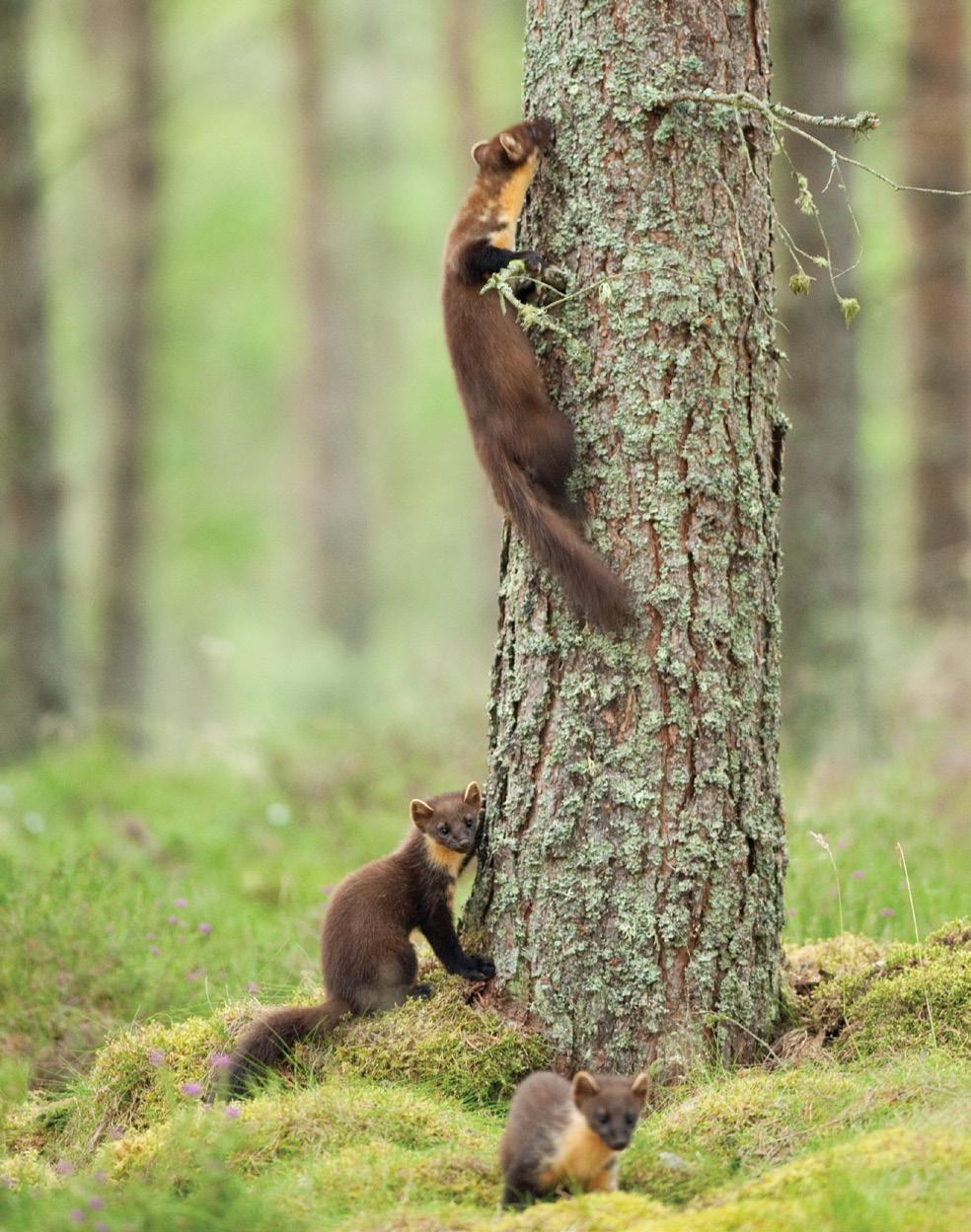

The Forest of Dean was chosen as an ideal habitat for the pine martens to forage, live and establish a sustainable population. Its features and connections to the surrounding landscapes provided space for the pine martens to travel, expand and thrive.
Following carefully planned trapping and translocation from healthy populations in the Scottish Highlands, the team at Gloucestershire successfully reintroduced 35 pine martens by the end of 2021. As of 2022, the population is now over 40, with at least four litters of kits born so far.
Modelling shows that the existing populations in Wales and the Forest of Dean should link up in about 10 years’ time, creating one large resilient population and re-establishing the pine marten in England.
And this is just the start! The project team at Gloucestershire Wildlife Trust hope that the pine martens spread to other areas in England and Wales through successful breeding and expansion across new territories. The next phase of the project involves monitoring the pine martens using radio tracking, camera traps, scat surveys and artificial den boxes.
PINE MARTENS © TERRY WHITTAKER/2020VISION; SETTING A CAMERA TRAP © NICK UPTON 10 | The Wildlife Trusts OUR YEAR FOR WILDLIFE & CLIMATE
CASE
STUDY:
Network for Nature
In partnership with the National Highways Environment and Wellbeing Fund, the Network for Nature programme was launched in 2021.
The initial phase of this four and a half year programme supports 28 projects, which are being delivered by 16 Wildlife Trusts in every region in England. The projects are all working to restore nature in areas impacted by historic major road building activity and will result in the creation of more than 878 hectares of woodland, peatland, grassland, wetland and the restoration of rivers and lakes — all for the benefit of people and wildlife.

The projects are varied and spread across the country, and include:

• The restoration and enhancement of Red Moss in Lancashire, a rare area of lowland peat bog adjacent to the M61. Re-wetting works will connect drier parts with wetter areas and increase the available habitat for wetland specialist wildlife.
• The creation of new wetland in the Lugg Valley in Herefordshire, becoming a stepping-stone for wildlife between two of the most important sites for wetland birds in the county.
• A pilot for dormouse bridges along the M5 in Somerset, reconnecting isolated populations of dormice and helping them spread into the wider landscape.
An additional £2,033,803 of funding for 10 projects across nine Wildlife Trusts has just been confirmed and we look forward to continuing our relationship with National Highways and delivering these exciting projects that will make a real difference to wildlife and nature.

& CLIMATE The Wildlife Trusts | 11
RED MOSS © JON HAWKINS; DORMOUSE © TERRY WHITTAKER/2020VISION; HAY STREWING © HEREFORDSHIRE WILDLIFE TRUST
OUR YEAR FOR WILDLIFE
taking
meaningful action
for nature and the climate, resulting in better decision making for the environment at both the local level and across the four nations of the UK.
Without people power, the fight to protect nature and tackle the climate crisis seems an insurmountable task. The Wildlife Trusts have a clear remit to engage and empower people of all ages, backgrounds and abilities to grow the ranks of those willing to take action and stand up for nature, or simply re-engage with and understand wild places and green spaces.
By increasing the number of people who can speak up and take action for wildlife, and diversifying the mix of individuals who step into our sector as staff, members or activists from underrepresented groups and communities, our collective voice will be louder, and reach further than ever before.

Our work to support people to take action and engage with communities has taken huge strides in the last year:
• The Wildlife Trusts called for young people to have greater access to nature following a poll which revealed 75% of children did not spend enough time outdoors enjoying the natural world.
• The Scottish Wildlife Trust’s Youth Manifesto for Action on Climate Change was published in November 2021, sending a strong message to governments, business leaders and individuals to cut emissions and limit climate change during the COP26 negotiations.
ENGAGING IN NATURE © BRONI LLOYD-EDWARDS
People are
114,600 people demanded the UK Government stick to their ban on bee-killing pesticides.
Over 37,000 people have made contact with their MP over an issue relating to nature, through a Wildlife Trust campaign.
214,500 people took part in a Wildlife Trust campaign calling for nature’s recovery.

OUR YEAR FOR WILDLIFE & CLIMATE The Wildlife Trusts
90,000 young people took part in a Wildlife Trustled education session with their school or youth group.
OUR
KEY STATS
Over 515,000 people connected with nature during June, through The Wildlife Trusts’ 30 Days Wild. | 13 PROTESTING © LEANNE
MANCHESTER
CASE STUDY:
Northern Ireland’s sustainable ‘fish city’
In October 2021, Ulster Wildlife, in partnership with the Belfast Food Network, launched an ambitious project to achieve ‘Sustainable Fish City’ status.
The scheme encourages restaurants, retailers, educational institutions and hospitals to sign up and pledge to buy, serve and promote sustainable seafood only. Less than one-third of UK fish stocks are harvested sustainably, so this campaign aims to protect the species at risk of extinction and to reduce the use of damaging methods that threaten the long term prospects of our valuable marine life.


The team at Ulster has already signed up local, awardwinning restaurant Fish City, and are working with other food providers across Belfast and Derry/Londonderry to gather momentum and put the area on the map as a leader in marine conservation and sustainable seafood.

14 | The Wildlife Trusts OUR YEAR FOR WILDLIFE & CLIMATE
FISH CITY © ULSTER WILDLIFE; LINE-CAUGHT MACKREL © TOBY ROXBURGH/2020VISION; MUSSELS © LARA
HOWE
CASE
STUDY:
Training the conservationists of the future
Thanks to National Lottery Heritage Fund, Birmingham and Black Country Wildlife Trust was able to create an innovative programme to help prepare people for a career in the environmental sector. The traineeship targeted local people over the age of 18 and, most importantly, those with a passion for the wild world and making a difference in their community!
Natural Prospects actively challenges the barriers people face in accessing careers in the environmental conservation sector by providing trainees with the chance to get handson, practical experience, leading to a Level 2 qualification in environmental conservation.


It’s no secret that more diversity is needed in the world of conservation, and that is something that this programme has also been tackling. Over four years the programme has welcomed people with a diversity of backgrounds, ages, cultures and experiences.

2022 is the final year of this fantastic programme, but since it began in 2019, all 13 trainees that have completed the scheme have secured employment or are continuing with further education. Happily, 90% of those trainees are working within the environmental sector and two have secured jobs at the Wildlife Trust.
Birmingham and Black Country Wildlife Trust has learnt a lot from Natural Prospects and is working to ensure people from all backgrounds have opportunities to work in the environment sector. The Trust is now looking for funding opportunities to continue this successful programme into the future.
OUR YEAR FOR WILDLIFE & CLIMATE The Wildlife Trusts | 15
RIVER © GUY EDWARDES/2020VISION; PROJECT PARTICIPANTS © BIRMINGHAM & BLACK COUNTRY WILDLIFE TRUST
The loss of nature is having a clear and measurable impact on both wildlife and people. Already threatened species are suffering from habitat loss, and mental and physical wellbeing is declining with fewer high-quality greenspaces for people to explore and enjoy. This is in addition to increased soil erosion and reduction in soil fertility, more extreme weather events including flooding and drought, and a reduction in our natural carbon stores like peatlands.
The natural world can provide its own solutions to combat and reverse these dangers, and together The Wildlife Trusts are using their collective voice to advocate for the implementation of nature-based solutions.

Over the past year, we have used our influence to encourage and guide society and government to look towards naturebased solutions to address the nature and climate crises.
• In June 2021, The Wildlife Trusts launched a report that highlighted the vital role that nature can play in economic recovery, housing, health and planning.
A Wilder Recovery — How to Build Back Smarter, Stronger, Greener aims to influence UK Government thinking on nature’s benefits to society.

• After five years studying the impacts of free-living beavers in Devon, the River Otter Beaver Trial Science and Evidence Report was published, finding that beavers bring ‘measurable benefits to people and wildlife’, including the reduction of flood risk, increased numbers of fish, and the creation of new wetland. They also received an 86% public approval rating.
• A new report published by Ulster Wildlife in May 2021 highlighted the importance of Northern Ireland’s coastal and marine habitats in helping to tackle the climate and nature crises, and achieving net zero greenhouse targets. The Blue Carbon Habitat Restoration in Northern Ireland Feasibility Study identifies what, where, and how much local coastal marine habitats, such as kelp forests, saltmarsh, seagrass meadows and shellfish, can remove and store carbon dioxide from the atmosphere.
MOSS © MARK HAMBLIN/2020VISION
Nature is playing a central and valued role in helping to address local and global problems.
At least 37,000 tCO2e carbon captured across The Wildlife Trusts’ 24,000 ha of woodland.
Every £1 invested in our volunteering programmes returns £8.50 in social value.
Nearly £2.2 million spent on 159 natural flood management activities.
More than 44,000 hours of Wildlife Trust-led health and wellbeing programmes delivered.
Over 14.5 million people have spent time in nature on a visit to a Wildlife Trust nature reserve.

OUR KEY STATS
| 17
OUR YEAR FOR WILDLIFE & CLIMATE The Wildlife Trusts
BEAVER © RUSSELL SAVORY
CASE STUDY:
Planting trees to save the Devonshire landscape
In December 2021, Devon Wildlife Trust launched the Saving Devon’s Treescapes project, which aims to plant a quarter of a million native trees over the next four years to counterbalance recent losses due to the devastating ash dieback disease.

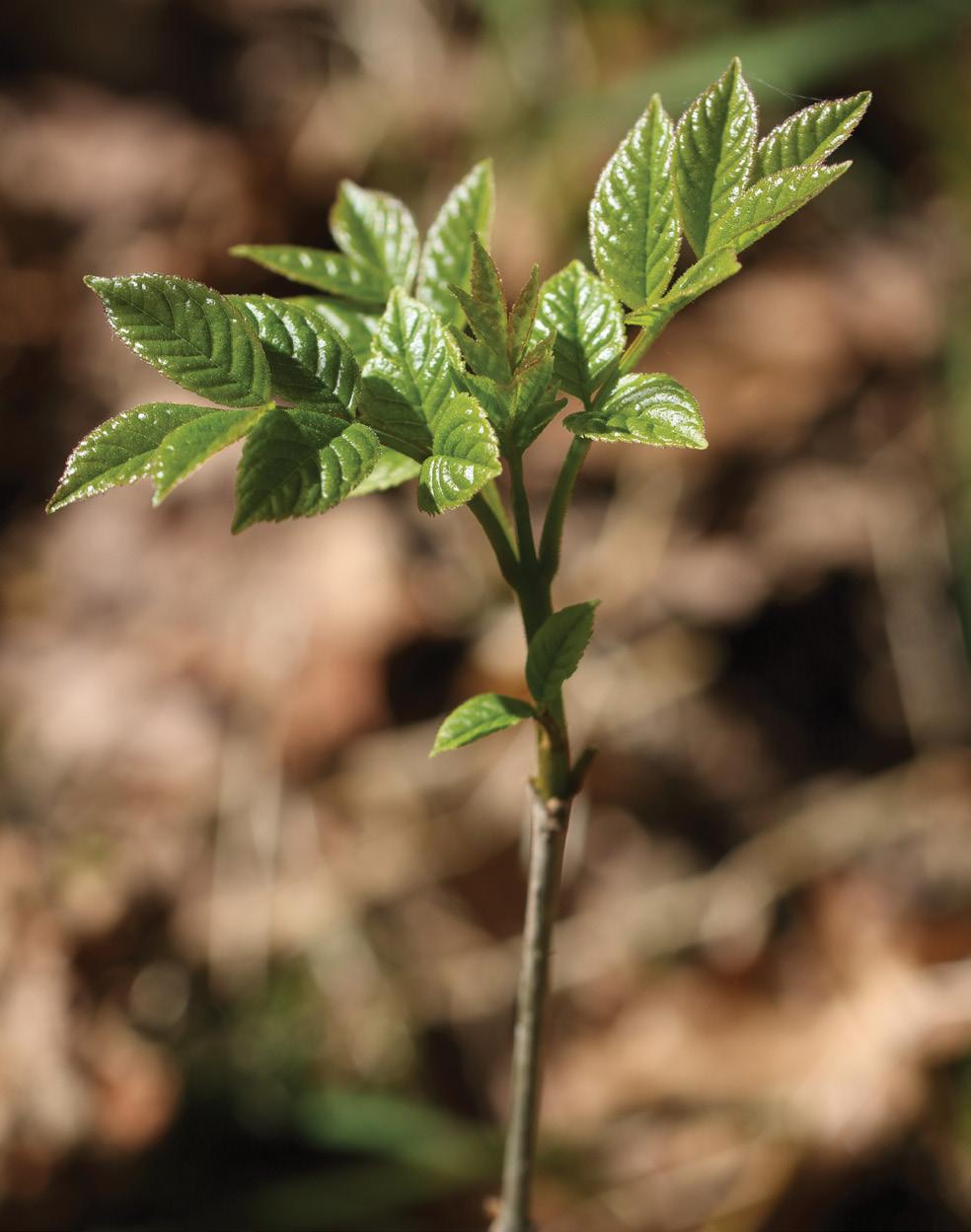
Funded by the National Lottery Heritage Fund, Devon Wildlife Trust’s ambitious plans include:
• Staging more than 100 ‘tree hub’ events for the general public to come along and collect a free tree to plant in their own garden.

• Making more than 300 visits to advise landowners on where and which species of tree to plant.
• Establishing a community tree nursery at Broadclyst, East Devon and supporting work with other communities to set up their own small tree nurseries elsewhere.
• Working with 80 schools to establish a network of 170 ‘school treescapes champions’ who will promote tree planting in their local communities.
• Planting 19 kilometres of new hedgerows.
• Monitoring the success of its own tree planting schemes, by monitoring the areas impacted by ash dieback and replanted with key Devon species.
• Celebrating the trees and natural heritage of Devon through a series of cultural events.
This programme will restore woodland habitat across the county, actively combatting the carbon loss caused through ash dieback and engaging local community members and businesses in the process.
18 | The Wildlife Trusts OUR YEAR FOR WILDLIFE & CLIMATE
PLANTING TREES © RICHARD OSBOURNE; ASH SAPLING © VAUGHN MATTHEWS; BUDDING FOREST © BEN HALL/2020VISION
CASE STUDY: Pentwyn Farm
In October 2021, Radnorshire Wildlife Trust bought a 66 hectare former livestock farm in Pentwyn using The Wildlife Trusts’ innovative ‘philanthropic loan’ scheme.
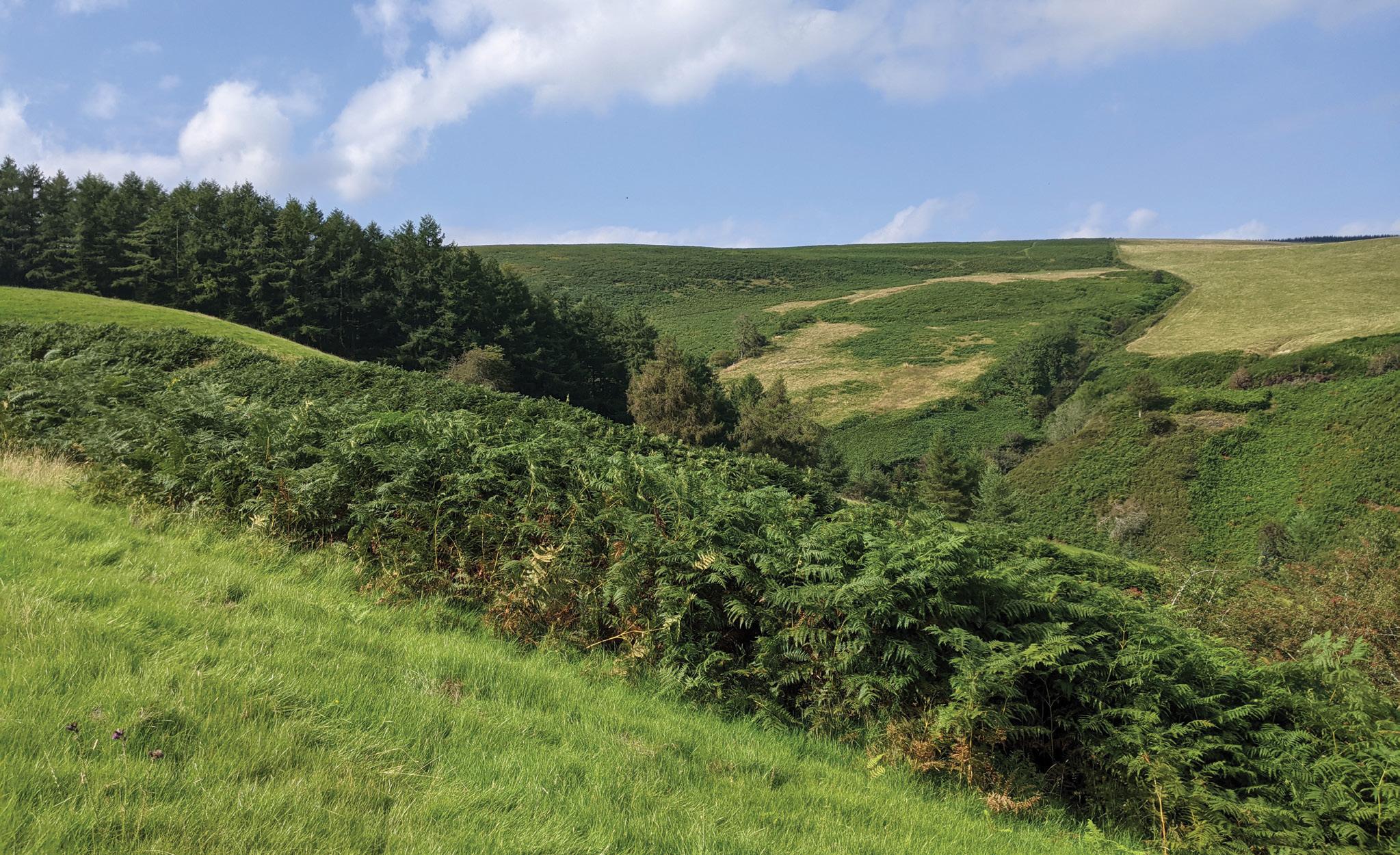
The land at Pentwyn is being transformed into diverse natural habitats that will be managed for wildlife. Already, in its first year, the project has completed comprehensive baseline studies and recorded drone footage to help showcase the transformation over time, and made connections with nearby schools and colleges, neighbouring landowners and the parish council to ensure the farm and its role in delivering nature-based solutions for the local community is valued and understood.
Future plans for Pentwyn include a mosaic of species-rich habitats maintained with low levels of grazing animals; public access to the site with a specific goal of bringing new audiences to visit, engage and fall in love with nature; and the creation of a ‘wild but welcoming’ area of beauty that contributes to the revitalisation of the rural economy and is a much-loved destination for visitors.

The philanthropic loan scheme enables Wildlife Trusts to access funds quickly when nature-rich land, or land with the potential for rewilding, becomes available for purchase, securing its long-term future. The terms of the loan provide the Wildlife Trust with the chance to fundraise and/or raise funds through enterprises linked to the site to pay it back over time.
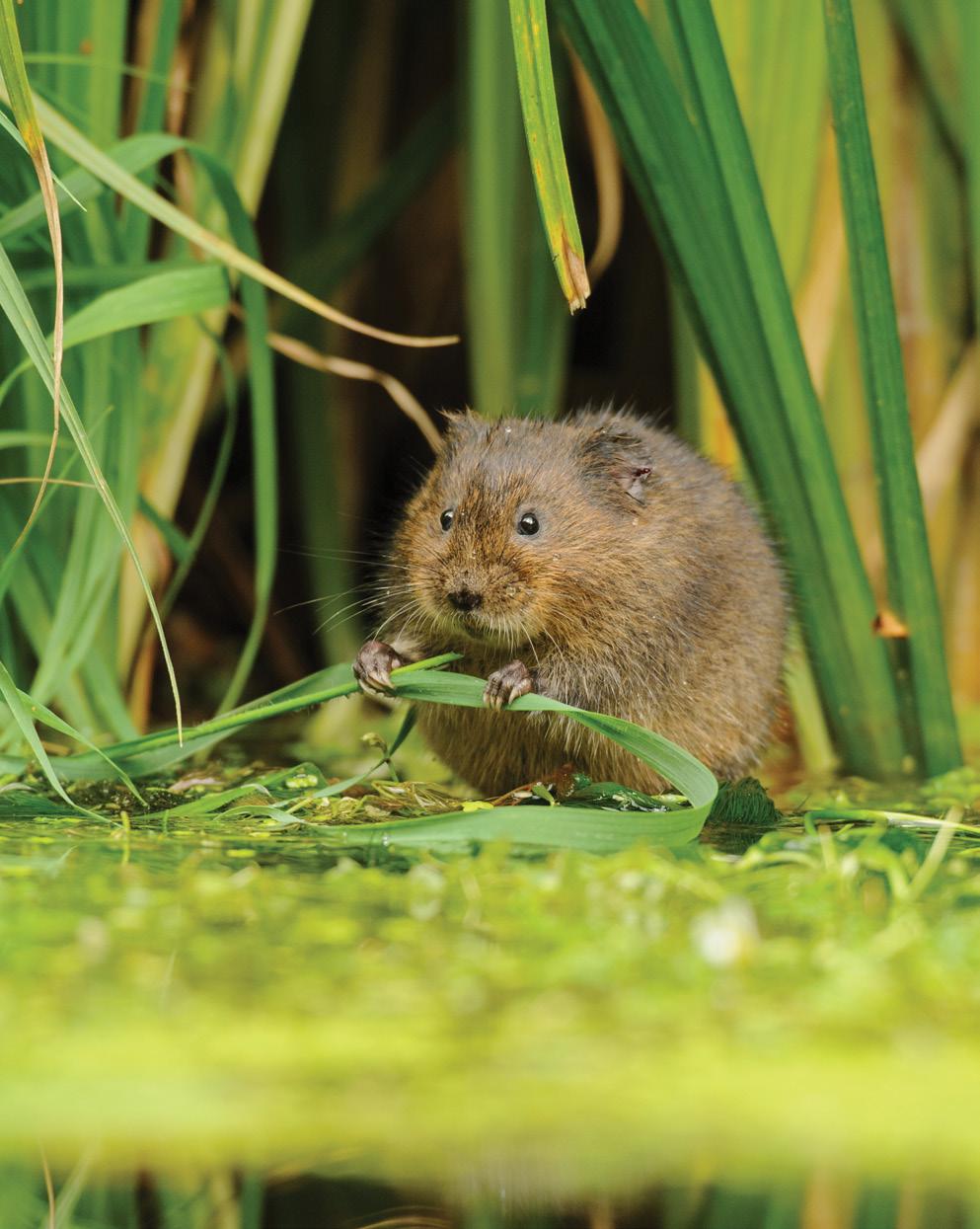
OUR YEAR FOR WILDLIFE & CLIMATE The Wildlife Trusts | 19
WATER
VOLE
© TERRY WHITTAKER/2020VISION; RED KITE © JON HAWKINS; PENTWYN FARM © RADNORSHIRE
WILDLIFE TRUST
OUR STRATEGIC TRANSFORMATIONS
Supporting and developing Wildlife Trusts as strong and effective independent actors.


Working effectively as a distributed network and collective movement.
Undergoing a ‘root and branch’ digital transformation.
Delivering a step-change in the scale and diversity of funding for nature’s recovery.
MATTHEWROBERTS
©

Somerset Wildlife Trust is working with local schools and youth groups to develop and deliver outdoor learning using the coast to connect children with nature and provide valuable learning experiences, including a new School Coastal Champion programme.
Inspiring community organising and mobilising, especially amongst young people.
Our work to inspire communities and improve engagement with young people is underway, with positive progress being made across all the federation.
‘Team Wilder’ is now embedded in Wildlife Trust vocabulary. Supported by a dedicated team at the Royal Society of Wildlife Trusts, an engaged network of community organisers throughout the Wildlife Trusts is equipped with resources, training and a range of creative and innovative approaches to encouraging and enabling individuals to take action for nature’s recovery.

© LIZCARTWRIGHT
Wilder Churches is a new partnership initiative between Somerset Wildlife Trust and the Diocese of Bath and Wells, helping communities engage with the wildlife in their local churchyard and work together to find ways to increase the value of these special places for wildlife.
BADGER © THINESH THIRUGNANASAMPANTHAR
RESERVE VISIT © TRAI ANFIELD
Getting our own house in order.
Ensuring our nature reserves and land assets are the foundation for nature’s recovery.



Develop clear and consistent evidencebased policies.
Invest in a high-skilled and diverse staff and volunteer network, and build a movement-wide learning culture.
OUR ENABLING PRIORITIES
JONHAWKINS
©
We have contributed to, advised on and responded to a wide range of policies and proposals, including consultations on Nature Recovery Green paper and the Environment Act targets, and worked on the Levelling Up and Regeneration Bill as part of the Better Planning Coalition.
The strength of our voice and our influence is key to achieving our ambitious goals and plans to vigorously defend nature.
We have developed strong and influential partnerships with businesses and individuals who have a vested interest in tackling the climate crisis and nature’s recovery, produced new and groundbreaking reports to address major environmental concerns, engaged with key decision-makers and leaders, and taken our campaigning activity to the next level to ensure that our collective voice is heard, listened to and acted upon.
Throughout 2021 and 2022 the federation joined forces to campaign against the use of peat in UK horticulture resulting in a ban on retail sales of peat compost from 2024.

Speak with a bold and confident voice, further increasing our impact and influence.
PUFFIN © CHARLES THODY
FAMILY © EVIE + TOM PHOTOGRAPHY
Thank you to our funders
NATIONAL LOTTERY HERITAGE FUND
This year, we were delighted to receive £5 million from The National Lottery Heritage Fund for Nextdoor Nature, a project which is bringing people together to help nature flourish in communities across the UK.
Wildlife Trusts are supporting communities to put their ideas into action and make small changes on their doorstep that will help put nature into recovery. Microprojects are being brought to life in places where green spaces and access to nature has eroded over time, driven by galvanised communities who are finding a new passion for wildlife.
PEOPLE’S POSTCODE LOTTERY
We are proud to have been supported by players of People’s Postcode Lottery for many years. This year, funding raised by players has supported Wildlife Trusts to care for special wild places and help people learn about and experience nature through wildlife events and outdoor education for children and young people.
It has also supported our ability to make policy topics more accessible to wider audiences through engagement initiatives such as Wild LIVE, our regular panel show featuring guest experts. In addition, it has funded the development of our Equality, Diversity and Inclusion (EDI) team and the valuable work they have undertaken in the past year, from the creation of staff networks for LGBTQ+, mental health and disability, to supporting Wildlife Trusts with accessibility audits, policy and framework development and legal compliance.
ANONYMOUS FUNDERS
We would also like to thank two grant funders who would like to remain anonymous. The first has supported our work to protect and restore damaged peatlands, which are vital allies in tackling the climate crisis and providing a home to rare and endangered wildlife.
The second has supported our work on digital transformation, which will enable the Wildlife Trusts movement to work more efficiently and effectively to restore nature and to help people take action to address the nature and climate crises.
ESMÉE FAIRBAIRN FOUNDATION
The Esmée Fairbairn Foundation Land Purchase loan fund offers low interest loans to Wildlife Trusts to assist organisations facing situations where land of a high conservation value (or utility) is available, but the seller is not prepared to wait until the conservation organisation raises funds. Between April 21 to March 22 the Esmée Fairbairn Foundation approved the following loans.
Trust Land purchased Hectares Loan amount
Wiltshire Wildlife Trust Bay Meadows 30 £200,000 Cheshire Wildlife Trust
Saltersford Farm 20 £465,150 Norfolk Wildlife Trust Sweetbriar Marshes 37 £475,000
The Wildlife Trust for Bedfordshire, Cambridgeshire & Northamptonshire
Strawberry Hill Farm 156 £975,000 towards a total cost of £3,300,000
22 | The Wildlife Trusts OUR YEAR FOR WILDLIFE & CLIMATE
Ramping up land in recovery for nature
In 2021, The Wildlife Trusts stepped up its land acquisition activity to make headway on the goal to reach 30 by 30: 30% of land and sea, managed in a way that allows nature to recover, by the year 2030.

Acquiring land is an expensive and time-consuming challenge, that is in part dependent on the generosity of our major donors and philanthropic lenders.
Philanthropic lenders have enabled Wildlife Trusts to rapidly purchase important land that has become available without the need to raise the funds first. This ensures the land can be used for rewilding projects rather than being at risk from damaging construction and development projects.
We would like to give a huge thank you to Julia Davies (We Have the Power), the pioneer of this type of philanthropic lending. Julia helped Dorset Wildlife Trust to purchase a site near Bere Regis in June 2021, and farmland in Pentwyn, in October 2021 (see details earlier in this report).
Thanks to our expanding group of Philanthropic Lenders 1,276 acres, at a cost of over £7 million, have now been secured for nature.

OUR YEAR FOR WILDLIFE & CLIMATE The Wildlife Trusts | 23
Thank you to all our funders, we couldn’t do it without you!
SITE VISIT
© JAMES BYRNE
Businesses we work with
We are proud to work with thousands of businesses to support nature’s recovery.
Working with others is crucial to tackling the nature and climate crises. Now, more than ever before, we are noticing that businesses are recognising the role they play in helping to bring nature closer to where people live and work. Through these relationships, we are creating more space for wildlife in urban areas and on farmland, we are helping nature play a bigger role in tackling some of our greatest challenges such as climate change and flooding, and we are providing many thousands of customers and employees with the opportunity to help bring our wildlife back.
Some of the businesses we work with include:


ABSEILING © RUSSELL HARPER
24 | The Wildlife
OUR
WILDLIFE
CLIMATE
A Hogan Lovells employee fundraising by abseiling
Trusts
YEAR FOR
&
HOGAN LOVELLS
We are proud to have been selected as Hogan Lovells’ official charity partner for four years (2020–2023).
The global law firm has two UK offices in London and Birmingham and has truly embraced the concept of staff wellbeing through connecting people with nature. Employees take part in ‘Wild Work Days’ to experience wildlife and habitats, and attend monthly ‘Lunch and Learn’ sessions delivered by Wildlife Trust staff. On top of providing important pro bono legal work and advice for Wildlife Trusts, Hogan Lovells employees undertake fundraising initiatives and challenges and have raised tens of thousands of pounds to further support our work.
CLEAR CHANNEL
In spring 2022, we started a five-year partnership with Clear Channel, one of the UK’s leading out of home media and infrastructure companies with more than 33,000 advertising sites nationwide.
The Wildlife Trusts is advising on locations for Clear Channel’s innovative planttopped Living Roof bus shelters (affectionately known as ‘Bee Bus Stops’) to support nature corridors in highly urban locations. Clear Channel are using their town centre infrastructure to help us reach millions of people with information about how we can all play a role in nature’s recovery.
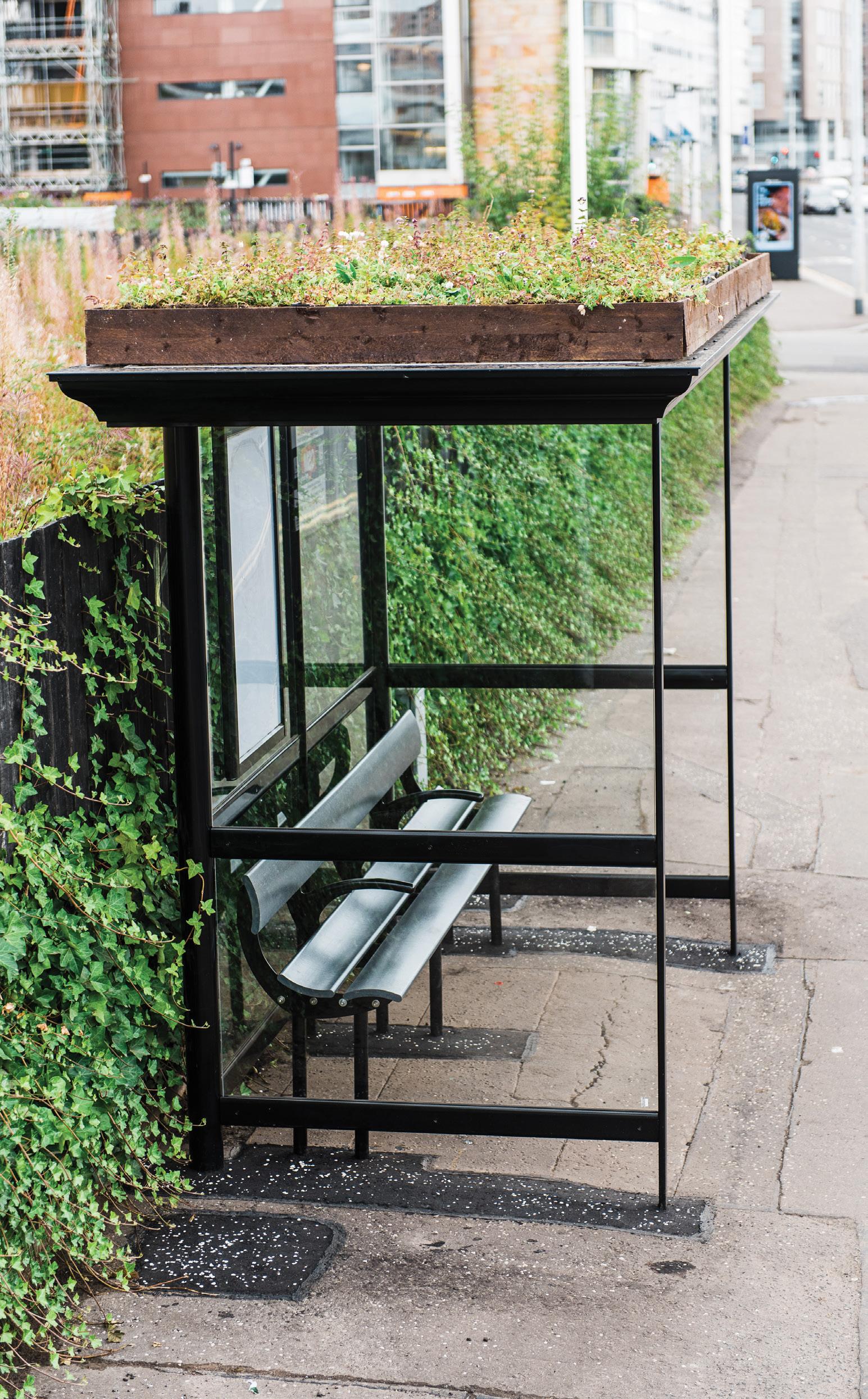
SIEMENS PLC
Since 2015 we have worked in partnership with Siemens Plc to encourage its employees to connect with nature by linking up with their local Wildlife Trusts and supporting local communities.
Keen to help drive net zero initiatives and manage its environment and community impacts, Siemens donated value in kind consultancy to examine the feasibility of installing electric vehicle charging points across Wildlife Trust nature reserves and visitor centres. This has been an invaluable resource, which contributes to Wildlife Trusts ‘getting our own house in order’, a commitment in our Strategy 2030, and helping us to reduce our scope 1 and 3 emissions, as we tackle the nature and climate emergencies.
BEE BUS STOP © MIKE SEYMOUR
BENCHMA R KBIODIVERSITY
Biodiversity Benchmark
Everyone has a role to play in reversing the nature crisis. By managing the land they own in a wildlife-friendly way, businesses can take an important step in helping nature’s recovery.
The Wildlife Trusts believe that the efforts of organisations leading by example should be celebrated, so we developed the Biodiversity Benchmark in 2007 and this certification has recognised the contribution of business landowners ever since.

Accreditation has been achieved across 52 sites covering 8,500 hectares of land managed by 13 organisations.
These organisations span sectors including leisure, transport, energy and construction.
CASE STUDY: Met Office
In 2021, the Met Office celebrated 10 consecutive years of holding the Wildlife Trusts’ Biodiversity Benchmark certification for their work at their headquarters in Exeter. They have developed a biodiversity management system, which contains several examples of good practice in fulfilment of the Biodiversity Benchmark requirements, including their Biodiversity Action Plan and a Continual Improvement Report for 2021-22. One example of continual improvement at the site is the number of bee orchids, which have increased from one flowering plant in 2008 to 390 in 2021! The site’s biodiversity database includes an impressive 486 species, of which 121 (25%) are noteworthy species.
SITE POND © S.HOLMAN’
Our

,
the breakdown of the 46 individual Wildlife Trusts’ accounts
and RSWT’s accounts (below), please see the
annual reports, which are available on their
websites. RSWT figures for national work
on
Trusts
charity income from charitable trusts and foundations, grants, donations, society lottery, legacies and corporates. Income for 2021-22 does not include £5.3m for Biffa Award, £1.9m for Our Bright Future and £1m for
Friendly Schools. Figures exclude inter-Trust grants and contributions. Wildlife Trust income £209.6m Wildlife Trust expenditure £175.2m Central charity (RSWT) income £6.7m Central charity (RSWT) spend £5.7m
collective finances For
(left),
relevant organisation’s
respective
completed
behalf of The Wildlife
movement. Central
Nature
His Majesty King Charles III
Liz Bonnin
Sir David Attenborough
Simon King
Tony Juniper
Dr Amir Khan
Iolo Williams
Gillian Burke
Prof Chris Baines
Nick Baker
Prof David Macdonald Bill Oddie
Julian Pettifer
Sir Robert Worcester
Dr Mya-Rose Craig
Prof Dave Goulson
Hannah Stitfall
David Oakes
Sophie Pavelle
Cel Spellman
Alison Steadman
Richard Walker James McVey
Maddie Moate
Peta Foxall Craig Bennett
Patron Vice Presidents President Ambassadors Presidents Emeriti Chair Chief Executive Royal Society of Wildlife Trusts Copyright 2022 Registered Charity Number 207238 Cover image © Bertie Gregory/2020VISION *Combined Wildlife Trust landholdings of 239,161 acres. Ranking as compared to list compiled by ABC Finance Limited. See: https://abcfinance.co.uk/blog/who-owns-the-uk/
The Wildlife Trusts is a movement made up of 46 Wildlife Trusts and a central charity (the Royal Society of Wildlife Trusts). Each is an independent charity with a shared mission. Help us achieve our vision of 30% of land and sea to be connected and protected for nature’s recovery by 2030... Get in touch... • Join us as a member • Remember us in your will • Speak up for wildlife
Volunteer your time • Work with us enquiries@wildlifetrusts.org instagram.com/thewildlifetrusts 01636 677711 twitter.com/wildlifetrusts wildlifetrusts.org youtube.com/thewildlifetrusts
Key people and supporters
•




























































